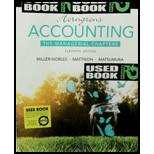
a)
Bonds:
They are long term negotiable instruments of debt issued by corporate entities to secure funds from the public. These funds are used to either fund long term capital expenditure or similar long term investment opportunities.
They represent steady income for the investor in the form of periodic interest payments by the entity issuing the bond. Bonds are issued at par, at premium or at a discount.
If the bonds will be issued at face value, premium or at a discount.
b)
Bonds:
They are long term negotiable instruments of debt issued by corporate entities to secure funds from the public. These funds are used to either fund long term capital expenditure or similar long term investment opportunities.
They represent steady income for the investor in the form of periodic interest payments by the entity issuing the bond. Bonds are issued at par, at premium or at a discount.
If the bonds will be issued at face value, premium or at a discount.
c)
Bonds:
They are long term negotiable instruments of debt issued by corporate entities to secure funds from the public. These funds are used to either fund long term capital expenditure or similar long term investment opportunities.
They represent steady income for the investor in the form of periodic interest payments by the entity issuing the bond. Bonds are issued at par, at premium or at a discount.
If the bonds will be issued at face value, premium or at a discount.
d)
Bonds:
They are long term negotiable instruments of debt issued by corporate entities to secure funds from the public. These funds are used to either fund long term capital expenditure or similar long term investment opportunities.
They represent steady income for the investor in the form of periodic interest payments by the entity issuing the bond. Bonds are issued at par, at premium or at a discount.
If the bonds will be issued at face value, premium or at a discount.
Want to see the full answer?
Check out a sample textbook solution
Chapter 14 Solutions
Horngren's Accounting
- Morgan Manufacturing bases its predetermined overhead rate on the estimated labor hours for the upcoming year. At the beginning of the most recently completed year, the company estimated the labor hours for the upcoming year at 70,000 labor hours. The estimated variable manufacturing overhead was $14.00 per labor hour and the estimated total fixed manufacturing overhead was $1,260,000. The actual labor hours for the year turned out to be 72,500 labor hours. Compute the company's predetermined overhead rate for the recently completed year.arrow_forwardTimberline Tools has annual sales of $745,800, total debt of $204,000, total equity of $396,000, and a profit margin of 5.6 percent. What is the return on assets (ROA)? Accounting problemarrow_forwardHey expert please provide step by step solution for general accountingarrow_forward

 AccountingAccountingISBN:9781337272094Author:WARREN, Carl S., Reeve, James M., Duchac, Jonathan E.Publisher:Cengage Learning,
AccountingAccountingISBN:9781337272094Author:WARREN, Carl S., Reeve, James M., Duchac, Jonathan E.Publisher:Cengage Learning, Accounting Information SystemsAccountingISBN:9781337619202Author:Hall, James A.Publisher:Cengage Learning,
Accounting Information SystemsAccountingISBN:9781337619202Author:Hall, James A.Publisher:Cengage Learning, Horngren's Cost Accounting: A Managerial Emphasis...AccountingISBN:9780134475585Author:Srikant M. Datar, Madhav V. RajanPublisher:PEARSON
Horngren's Cost Accounting: A Managerial Emphasis...AccountingISBN:9780134475585Author:Srikant M. Datar, Madhav V. RajanPublisher:PEARSON Intermediate AccountingAccountingISBN:9781259722660Author:J. David Spiceland, Mark W. Nelson, Wayne M ThomasPublisher:McGraw-Hill Education
Intermediate AccountingAccountingISBN:9781259722660Author:J. David Spiceland, Mark W. Nelson, Wayne M ThomasPublisher:McGraw-Hill Education Financial and Managerial AccountingAccountingISBN:9781259726705Author:John J Wild, Ken W. Shaw, Barbara Chiappetta Fundamental Accounting PrinciplesPublisher:McGraw-Hill Education
Financial and Managerial AccountingAccountingISBN:9781259726705Author:John J Wild, Ken W. Shaw, Barbara Chiappetta Fundamental Accounting PrinciplesPublisher:McGraw-Hill Education





